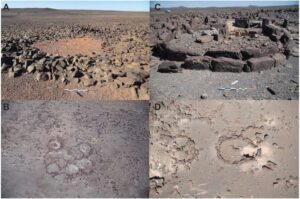 To date, little has been known about people living in north-western Saudi Arabia during the Neolithic—the period traditionally defined by the shift to humans controlling food production and settling into communities with agriculture and domesticated animals.
To date, little has been known about people living in north-western Saudi Arabia during the Neolithic—the period traditionally defined by the shift to humans controlling food production and settling into communities with agriculture and domesticated animals.
The piecemeal evidence available hinted traditional ideas—of small struggling groups constantly on the move across the barren lands—needed to be revisited.
Now, an Australian-led team has released new research in the journal Levant on monumental buildings we call “standing stone circles.” The findings are helping to rewrite what we know about the people who lived on this land between 6,500 and 8,000 years ago.
Our evidence reveals what they ate, what tools they used and even the jewelry they wore. It leads us to think these people weren’t struggling so much after all, but rather had found complex and strategic ways to thrive on the land for millennia.
The project
Over the past five years, our team of researchers has studied 431 standing stone circles in the AlUla and Khaybar regions of north-west Saudi Arabia, as part of an ongoing project sponsored by the Royal Commission for AlUla. Of the 431 structures, 52 have been surveyed in detail and 11 excavated.
Our latest findings come from a selection of buildings found on the Harrat ‘Uwayrid—a volcanic plateau formed over millennia. The dense clusters of standing stone circles on the harrat show us how complex these mobile pastoralist communities actually were. We also recovered remnants left behind by the people who lived in these buildings for more than 1,000 years.
We used a range of modern and traditional techniques to tackle the practical limitations of working in such a remote and rugged landscape. Aerial survey by helicopter helped us identify examples of the dwellings across 40,000 square kilometers of basalt and sandy desert. Drones were also used to make plans of the sites, some almost three hectares in size.















